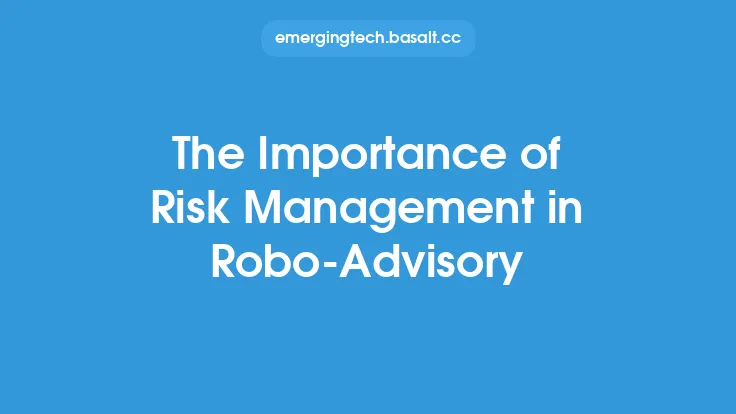The financial industry has witnessed a significant transformation with the advent of robo-advisory services, which leverage machine learning algorithms to provide automated investment advice. At the heart of these services lies the concept of machine learning, a subset of artificial intelligence that enables systems to learn from data and make predictions or decisions without being explicitly programmed. In the context of robo-advisory, machine learning plays a crucial role in analyzing vast amounts of financial data, identifying patterns, and making informed investment decisions.
Introduction to Machine Learning in Robo-Advisory
Machine learning in robo-advisory involves the use of algorithms that can analyze large datasets, including market trends, economic indicators, and customer information. These algorithms can be broadly classified into two categories: supervised and unsupervised learning. Supervised learning involves training the algorithm on labeled data, where the correct output is already known, to make predictions on new, unseen data. Unsupervised learning, on the other hand, involves identifying patterns and relationships in unlabeled data. In the context of robo-advisory, supervised learning is commonly used to predict stock prices, identify high-performing assets, and optimize investment portfolios.
Key Machine Learning Algorithms Used in Robo-Advisory
Several machine learning algorithms are used in robo-advisory, including decision trees, random forests, support vector machines, and neural networks. Decision trees are used to classify customers into different risk categories and recommend investment portfolios accordingly. Random forests are used to predict stock prices and identify high-performing assets. Support vector machines are used to optimize investment portfolios by minimizing risk and maximizing returns. Neural networks, on the other hand, are used to analyze complex patterns in financial data and make predictions about future market trends.
Data Preprocessing and Feature Engineering
Data preprocessing and feature engineering are critical components of machine learning in robo-advisory. Data preprocessing involves cleaning, transforming, and formatting the data to make it suitable for analysis. Feature engineering, on the other hand, involves selecting the most relevant features or variables that can help the algorithm make accurate predictions. In the context of robo-advisory, data preprocessing may involve handling missing values, removing outliers, and normalizing the data. Feature engineering may involve selecting features such as stock prices, trading volumes, and economic indicators that can help the algorithm make informed investment decisions.
Model Training and Evaluation
Model training and evaluation are critical steps in machine learning-based robo-advisory. Model training involves training the algorithm on a large dataset to learn patterns and relationships. Model evaluation, on the other hand, involves testing the performance of the algorithm on a separate dataset to evaluate its accuracy and robustness. In the context of robo-advisory, model training may involve using techniques such as cross-validation to evaluate the performance of the algorithm on unseen data. Model evaluation may involve using metrics such as mean absolute error, mean squared error, and R-squared to evaluate the accuracy of the algorithm.
Challenges and Limitations of Machine Learning in Robo-Advisory
While machine learning has revolutionized the field of robo-advisory, there are several challenges and limitations that need to be addressed. One of the major challenges is the quality and availability of data. Machine learning algorithms require large amounts of high-quality data to make accurate predictions. However, financial data can be noisy, incomplete, and biased, which can affect the accuracy of the algorithm. Another challenge is the interpretability of machine learning models. While machine learning models can make accurate predictions, they can be difficult to interpret, which can make it challenging to understand the reasoning behind the predictions.
Future of Machine Learning in Robo-Advisory
The future of machine learning in robo-advisory is exciting and promising. With the increasing availability of data and advances in machine learning algorithms, robo-advisory services are likely to become more sophisticated and accurate. One of the trends that is likely to shape the future of robo-advisory is the use of deep learning algorithms, which can analyze complex patterns in financial data and make predictions about future market trends. Another trend is the use of alternative data sources, such as social media and sensor data, to make more informed investment decisions.
Regulatory Framework and Compliance
The regulatory framework and compliance are critical components of machine learning-based robo-advisory. Regulatory bodies such as the Securities and Exchange Commission (SEC) and the Financial Industry Regulatory Authority (FINRA) have established guidelines and regulations for robo-advisory services. These regulations require robo-advisory services to disclose their investment strategies, risks, and fees to customers. They also require robo-advisory services to have adequate risk management systems in place to protect customer assets. Machine learning algorithms used in robo-advisory must be designed and implemented in a way that complies with these regulations and guidelines.
Best Practices for Implementing Machine Learning in Robo-Advisory
There are several best practices that can be followed to implement machine learning in robo-advisory. One of the best practices is to use high-quality data that is relevant to the investment strategy. Another best practice is to use techniques such as cross-validation to evaluate the performance of the algorithm on unseen data. It is also important to use metrics such as mean absolute error, mean squared error, and R-squared to evaluate the accuracy of the algorithm. Additionally, it is important to have a robust risk management system in place to protect customer assets and comply with regulatory requirements.
Conclusion
In conclusion, machine learning plays a critical role in robo-advisory, enabling systems to analyze vast amounts of financial data, identify patterns, and make informed investment decisions. While there are several challenges and limitations associated with machine learning in robo-advisory, the future of this technology is exciting and promising. By following best practices and complying with regulatory requirements, robo-advisory services can use machine learning to provide accurate and personalized investment advice to customers. As the field of robo-advisory continues to evolve, it is likely that machine learning will play an increasingly important role in shaping the future of investment advice and financial planning.





